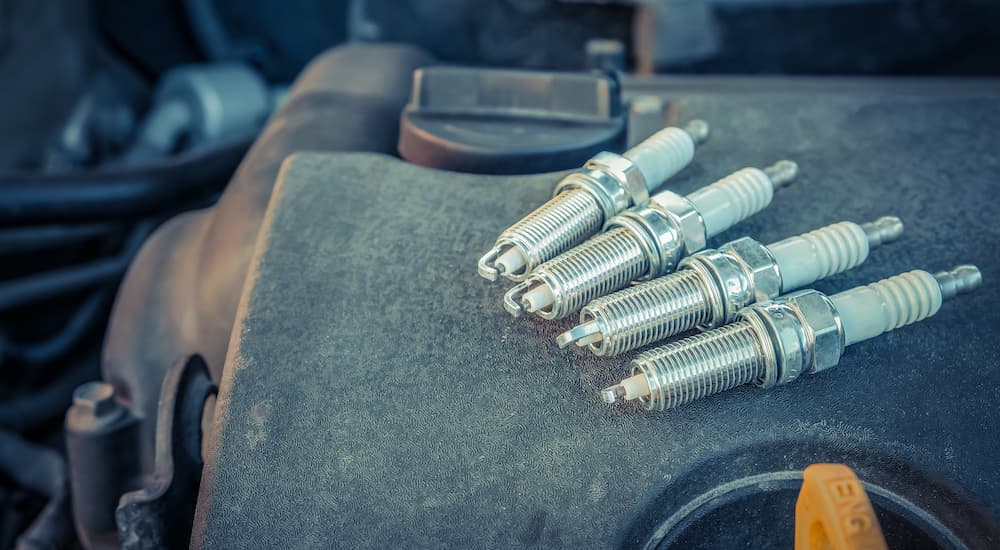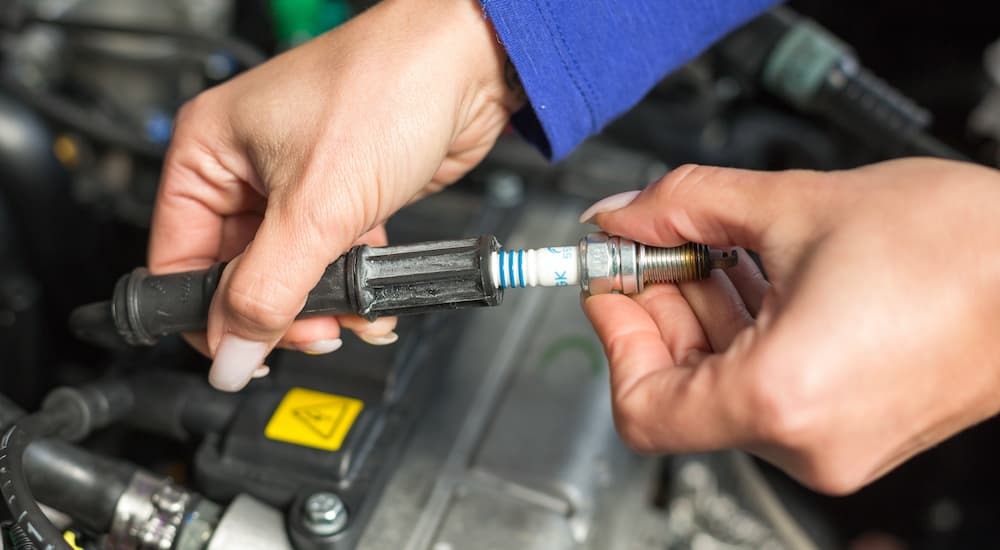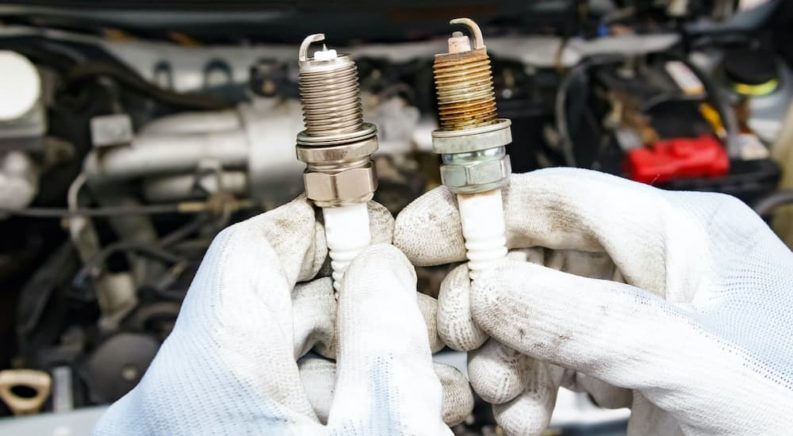Most gearheads enjoy endlessly discussing big automotive-related topics, like diesel vs gas, electrification, and which manufacturer builds the best cars, trucks, and SUVs. Talking about Nissan service doesn’t usually involve the topic of spark plugs, but your car won’t run without these little marvels, so we think they deserve a little airtime.
Spark plugs are aptly named because their job is to ignite (or spark) the fuel/air mix to generate the combustion necessary to move your car. They take a lot of abuse, specifically exposure to ultra-hot temperatures and gunky engine deposits that, over time, can diminish performance and eventually cause spark plugs to fail. This is especially true for older vehicles.
Understanding a spark plug’s basic architecture and how they work is helpful for two reasons: first, it might help you diagnose the root cause of a myriad of annoying mechanical issues, and second, you’ll know when it’s time to replace them. We’ll focus on the Nissan Rogue for demonstration purposes, but this guide will work for any vehicle or combustion engine.
Spark Plug Components
The small but mighty spark plug is a remarkably simple part that performs a very complex – and critical – function. A spark plug consists of the terminal nut, ribs, insulator, glass resistor, a gasket, some threads, and a pair of electrodes that protect a copper core. All of these components live within a protective housing, and precious metals like nickel, platinum, or iridium act as conductors.
The main job of a spark plug is to deliver an electrical charge (or spark) that ignites the fuel/air mixture responsible for starting an engine. The three main spark plug components, the housing, electrodes, and insulator, help the current flow through the engine safely and efficiently, relying on nickel alloy electrodes and a copper core for optimal thermal conductivity.
The main center electrode is a tiny protrusion at the end of the spark plug that looks like the tip of a pen. For such a small component, it’s the epicenter of the spark plug’s function. The tip is commonly made of iridium alloy, a precious metal that’s both heat resistant and strong enough to resist oxidation as it ages, but there are also platinum and copper tips. The center electrode is protected by a ground electrode that curves around it.
Assorted gaskets and insulation layers create an airtight environment within which the electrical current can flow efficiently. An airtight environment is also necessary to preserve the air/fuel mixture within the engine’s combustion chambers (to eliminate backfiring and other issues). Helping this along is the spark plug’s glass seal, which prevents gaps even when extreme temperature swings are present.

Evidence of Failing Spark Plugs
One of the most frustrating engine issues is random knocks and pings. Diagnosing a specific mechanical problem from a general condition like engine noise isn’t easy, but sometimes the solution is simple and inexpensive. If your spark plugs misfire, your engine will tell you. Bad spark plug ignition timing compromises engine performance and causes sputtering and other noises.
Another telltale sign of a malfunctioning or worn spark plug is a jerky sensation when you start your engine. It may be subtle, but you’ll notice an uncharacteristic roughness to the start-up process. Healthy spark plugs create optimal combustion, and your engine relies on that preciseness for just about every function, from starting to idling, but bad spark plugs are most noticeable when you start your engine.
Of course, the job of the spark plugs doesn’t end once the engine starts – they keep on firing thousands of times a minute for as long as your engine is running. A low-quality spark or one that happens a fraction of a second too late will directly affect your vehicle’s performance. You’ll notice sluggish acceleration and a general decrease in overall performance, as well as a rougher shift between gears. Sometimes it’s subtle, but if you know your car well, you’ll definitely notice a difference.
Finally, bad spark plugs are also extremely bad for the environment. Testing by Denso, a leading spark plug manufacturer, suggests that failing spark plugs could increase harmful emissions by as much as 30 percent. Not only that, but your fuel economy may suffer. This is especially true with older vehicles that don’t contain the same emissions-reducing technology. Replacing your old spark plugs with new state-of-the-art ones can make a big difference.
How to Replace a Spark Plug
The effort required to replace your engine’s spark plugs has everything to do with accessibility and advancements in automotive engineering. Older cars relied on a complex network of parts and wires to transport a spark from the plug to the combustion chamber. Components like distributor caps are long gone, but in the past, all points were part of the inspection process, and each part was subject to wear.
Today’s vehicles – like the 2021 Nissan Rogue – don’t have distributor caps or tangles of wire attached to multiple spark plug coils. Instead, the only replaceable parts are the coil packs and the spark plug itself. Nissan uses long-lasting iridium platinum-tipped spark plugs, which probably won’t need to be replaced for at least 100,000 miles, or if the plug gap exceeds 1.35mm. The only caveat is if you do any extreme driving, like excess off-roading or continuous, long-haul mileage driving.
If you own an older car, you’ll find the spark plugs by locating the wires that lead to them. They’re usually concealed by plug covers, and if you have a V6 or V8 engine, they’ll be evenly distributed on each side. Make sure the engine is cool, then carefully use a deep socket wrench to unscrew the old spark plugs.
How do you know if it’s time to replace them? Measure the gap between the center electrode and the ground electrode, and if it’s more than recommended by your owner’s manual, you’ll need to replace them. Older cars can require new spark plugs as frequently as every 12,000 miles, but newer plug designs have increased their life considerably. Since they’re pretty inexpensive, this is more of a time investment for DIY’ers.

Every Component of Your Engine is Important
Today’s automotive engines are paradoxically simple (from a component standpoint) and complex (from a technology standpoint). Within the ignition system, there’s only one part that needs regular replacing – spark plugs. Luckily, since replacement now happens at 100,000-mile intervals, it’s not as important to learn how to do it yourself.
Spark plugs are but one example of the thousands of components that contribute to your vehicle’s performance. In an age where most every other engine part is automated or computerized, the humble electric spark is still necessary. Without it, your engine won’t run.
Nowadays, vehicles contain tidy emissions systems that newer platinum-tipped spark plugs are more compatible with versus the less environmentally-friendly engines of years past. For that reason, installing state-of-the-art spark plugs in old engines won’t necessarily change the replacement interval. Older engines run richer, which can damage a spark plug that’s designed for more consistent emissions conditions.
To summarize, keeping a newer set of spark plugs on your older car improves performance and fuel efficiency, decreases emissions, and allows for a smoother engine idle. At a cost of around $10 each, it’s not expensive to replace them, and if you can DIY the swap, you’ll save even more. The result is a healthier engine long-term and optimal performance every day you drive it.

